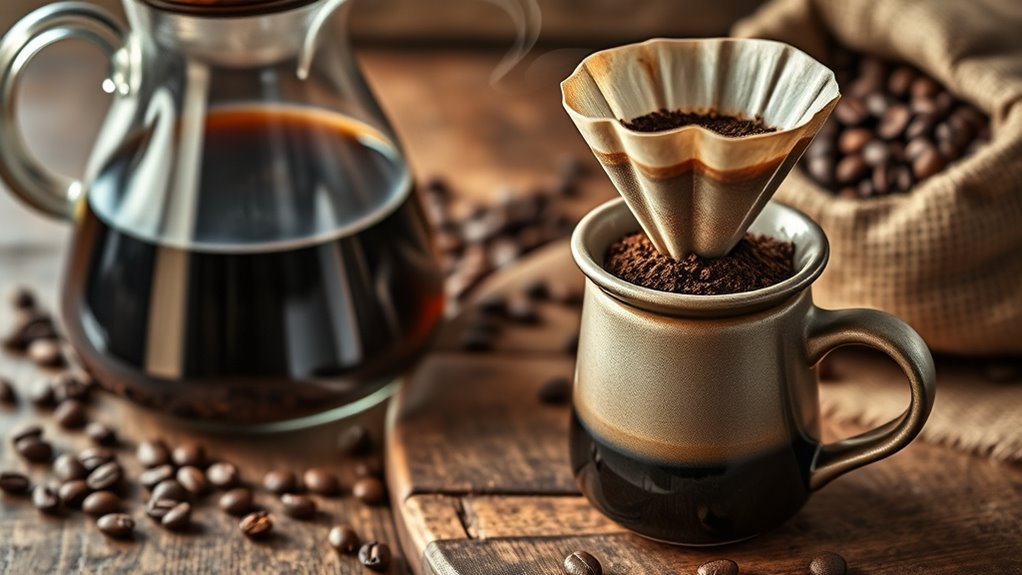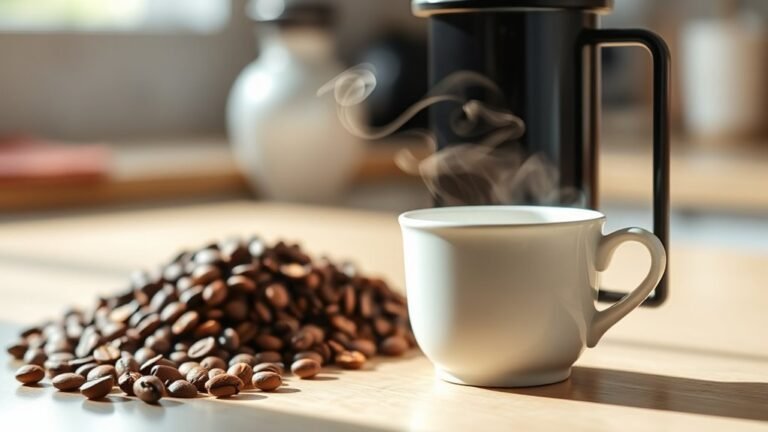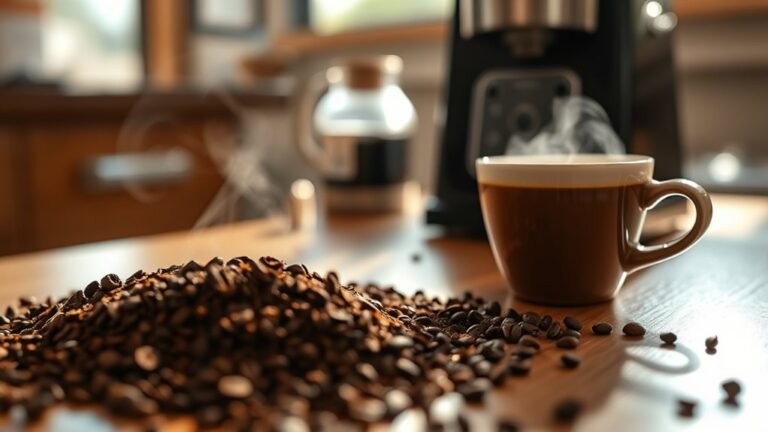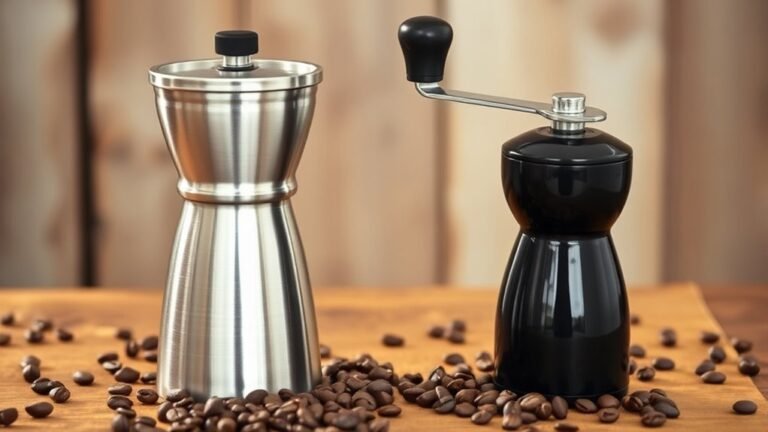The Best Coffee for Pour-Over
For the best pour-over, choose freshly roasted beans within 7 to 14 days, ideally medium to light roast single-origin or balanced blends, ensuring uniform size and density for even extraction. Grind immediately before brewing to a medium-coarse size to optimize water flow and flavor clarity. Control water temperature between 195°F and 205°F and extraction time between 2.5 to 4 minutes for balanced acidity and sweetness. Exploring the specifics of bean origin, roast, and grind techniques will elevate your brew to precision.
Understanding Pour-Over Brewing

Although pour-over brewing might seem straightforward, mastering its technique requires understanding the precise interaction between water temperature, grind size, and extraction time, as these factors directly influence the coffee’s flavor profile and clarity. When you control water temperature—ideally between 195°F and 205°F—you optimize coffee extraction, ensuring balanced acidity and sweetness without bitterness. Adjusting grind size alters flow rate; a finer grind slows water passage, increasing extraction, while a coarser grind speeds it up, risking under-extraction. Timing must harmonize with these variables, typically between 2.5 to 4 minutes, to prevent over- or under-extracted brews. By refining these brewing techniques, you gain freedom to dial in your perfect cup, highlighting nuanced flavors and achieving clarity that distinguishes pour-over coffee from other methods.
Key Characteristics of Pour-Over Coffee Beans
Several specific characteristics distinguish coffee beans ideal for pour-over brewing, directly impacting the clarity and complexity of your cup. You’ll want to select coffee bean varieties with bright acidity and pronounced flavor notes, as pour-over methods emphasize clarity and nuanced profiles. Medium to light roasts typically preserve these attributes better than darker roasts, which can mute subtle flavors. The beans should also have uniform size and density to guarantee even extraction during your precise pour-over process. Additionally, fresh, high-quality beans with minimal defects allow the brewing method’s delicate water flow to highlight intricate aromas and brightness. By focusing on these factors, you gain the freedom to tailor your brew’s balance and depth, fully leveraging the pour-over’s capability to reveal each coffee bean variety’s distinct character.
Single-Origin vs. Blends for Pour-Over
When choosing between single-origin coffees and blends for pour-over, you’ll need to contemplate how each approach affects flavor clarity and complexity. Single origin benefits lie in their distinct, traceable flavor profiles, allowing you to experience specific regional characteristics—like a bright Ethiopian citrus or a rich Colombian chocolate note. This clarity offers freedom to appreciate unique terroirs precisely. Conversely, blend advantages come from their balanced, consistent taste, achieved by combining beans to mitigate single origin inconsistencies. Blends can enhance complexity by layering flavors, providing a harmonious cup that’s less prone to variation. For pour-over, if you desire transparency and a pure expression, single-origin is ideal. But if you seek complexity and reliability, blends offer a crafted experience that suits your exploratory freedom.
Light Roast vs. Medium Roast for Pour-Over

If you want to highlight the intricate acidity and nuanced origin characteristics in your pour-over, light roasts are your best bet, as they preserve more of the coffee’s inherent chemical compounds. The light roast benefits include a higher concentration of chlorogenic acids and complex aromatics, which amplify brightness and floral notes. Conversely, medium roasts offer a more balanced cup by developing sugars and reducing acidity through Maillard reactions, delivering medium roast advantages like enhanced body and sweetness without overpowering bitterness. When you choose between these roasts, consider your extraction parameters—light roasts require slightly higher temperatures and longer brew times to reveal their potential, while medium roasts are more forgiving. Ultimately, your freedom to experiment with these roast levels lets you tailor the pour-over experience to your precise taste preferences.
Flavor Profiles That Shine in Pour-Over
When you brew pour-over, coffees with bright citrus notes stand out due to the method’s ability to highlight acidity and clarity. You’ll also find that balanced floral aromas are enhanced, providing a nuanced sensory experience. Focusing on these flavor profiles can elevate the complexity and brightness in your cup.
Bright Citrus Notes
Bright citrus notes in coffee bring a lively acidity and complex aroma that pour-over brewing method accentuates exceptionally well. When you use precise brewing techniques—such as controlling water temperature between 195-205°F and employing a consistent pour rate—you highlight the coffee’s natural brightness without overwhelming bitterness. These citrus pairings, often lemon, orange, or grapefruit undertones, emerge clearly due to the pour-over’s ability to extract nuanced flavors selectively. You’ll find that this method preserves the coffee’s delicate oils and acids, enhancing the crispness and clarity of each sip. To truly enjoy these bright citrus notes, experiment with grind size and bloom time to balance extraction. This lets you savor a cup that feels vibrant, invigorating, and perfectly tailored to your free-spirited palate.
Balanced Floral Aromas
Delicate floral aromas in coffee offer a nuanced sensory experience that the pour-over method excels at preserving and highlighting. When you opt for beans with balanced floral notes, the pour-over’s controlled extraction accentuates subtle fragrances without overwhelming bitterness or acidity. This aroma balance creates a refined cup, inviting you to explore complex layers of scent and flavor.
Key considerations for enjoying balanced floral aromas in pour-over include:
- Selecting single-origin beans known for jasmine, lavender, or rose-like floral notes
- Using medium grind size to optimize extraction of volatile aromatic compounds
- Maintaining water temperature between 195°F and 205°F to prevent aroma degradation
- Pouring technique that evenly saturates grounds, ensuring uniform flavor release
This precise approach reveals the delicate bouquet that pour-over brewing is uniquely suited to deliver.
How Freshness Affects Pour-Over Coffee
You’ll want to pay close attention to the roast date since coffee begins to lose volatile aromatics and flavor compounds within days of roasting. Grinding your beans immediately before brewing preserves these delicate oils and prevents oxidation that dulls taste. Plus, using airtight, opaque containers stored in a cool, dry place slows staling and maintains ideal freshness for your pour-over.
Roast Date Importance
Although many factors influence the quality of your pour-over coffee, the roast date plays a critical role in preserving the beans’ perfect flavor profile. Freshly roasted beans retain volatile aromatics and nuanced compounds essential for capturing the intended roast profile. As time passes, oxidation degrades these elements, flattening acidity and muting complexity. To enhance your brew temperature and extraction, you need beans roasted within the last 7 to 14 days. Consider these points:
- Peak flavor window aligns closely with ideal roast profiles, enhancing brightness and balance
- Stale beans reduce solubility, causing uneven extraction at typical pour-over temperatures
- The degradation rate varies by roast level—lighter roasts age faster than darker ones
- Proper storage slows freshness loss but can’t substitute for a recent roast date
Prioritize roast date to reveal the full potential of your pour-over experience.
Grinding Timing Impact
Anyone aiming for the perfect pour-over knows that grinding timing greatly influences coffee freshness and extraction quality. Grinding your beans immediately before brewing preserves volatile aromatics and oils essential for a vibrant cup. If you grind too early, oxidation begins, degrading flavor compounds and altering the ideal extraction time. When you control grind size precisely at the moment of brewing, you maintain consistent particle distribution, which directly impacts extraction time and flavor balance. Coarser grinds require longer extraction, while finer grinds speed it up; stale grounds, however, compromise this relationship, causing uneven extraction and muted complexity. By grinding just before pouring, you guarantee your pour-over captures the freshest essence, granting you freedom to experiment with grind size and extraction time to reveal your coffee’s full potential.
Storage Methods Effects
Grinding your beans right before brewing locks in freshness, but how you store those beans beforehand plays an equally important role in preserving their aromatic and flavor integrity. Exposure to oxygen, light, and moisture accelerates staling, diminishing the nuanced profiles vital for pour-over precision. To optimize freshness, consider these factors:
- Use airtight storage containers with one-way valves to expel CO2 while preventing oxygen ingress.
- Maintain consistent humidity control, ideally below 60%, to prevent mold growth and flavor degradation.
- Store beans in a cool, dark place away from direct sunlight and heat sources to slow oxidation.
- Avoid frequent opening of containers, as repeated air exposure hastens staleness.
Implementing these practices guarantees your pour-over coffee exhibits the clarity, balance, and vibrancy that freshly ground beans promise.
Popular Coffee Growing Regions for Pour-Over Beans
When selecting beans for pour-over brewing, understanding the distinct characteristics of coffee growing regions can greatly enhance your cup’s complexity and balance. Ethiopian beans offer bright acidity and floral notes, ideal for a vibrant profile. Colombian coffee provides a balanced sweetness with medium body, while Kenyan varieties stand out with bold acidity and fruity undertones. Costa Rican and Guatemalan origins deliver clean, crisp flavors with nuanced citrus and chocolate hints. Brazilian selections tend toward nuttier, chocolate-rich profiles, perfect for smoother cups. Panamanian beans are prized for their delicate, tea-like qualities, adding elegance. Sumatra coffee, with its earthy, full-bodied depth, offers a contrasting weight and complexity. Knowing these regional traits lets you select beans that align precisely with your flavor freedom and pour-over aspirations.
Grinding Tips for Optimal Pour-Over Extraction

You’ll want to dial in a grind size that’s medium-coarse to guarantee balanced extraction without over-extracting bitterness or under-extracting sourness. Consistency in particle size is critical; uneven grounds lead to channeling and uneven flow rates during brewing. Focus on uniformity to maximize surface area exposure and achieve a clean, well-rounded cup.
Grind Size Importance
Although many factors influence your pour-over coffee’s flavor, grind size plays a pivotal role in controlling extraction rate and balance. Getting your grind settings right guarantees water flows at an ideal speed, avoiding under or over-extraction. When adjusting grind size, consider these key points:
- Finer grinds increase surface area, accelerating extraction but risk bitterness.
- Coarser grinds slow extraction, potentially causing sourness or weak flavor.
- Match grind size with your brewing techniques, like pour speed and filter type.
- Small grind size adjustments dramatically affect brew time and taste profile.
Mastering grind size gives you freedom to tailor your cup’s clarity, body, and brightness. Experiment systematically, noting how grind adjustments interplay with your techniques for the perfect balance in every brew.
Consistency and Uniformity
Since grind consistency directly impacts extraction uniformity, achieving a uniform particle size is critical for ideal pour-over coffee. Uneven grounds create channels where water flows too quickly, resulting in under-extracted, sour flavors, while finer particles extract too rapidly, causing bitterness. To maintain precision, use a burr grinder rather than a blade grinder, as burrs produce consistent granules essential for balanced brewing techniques. You should also adjust grind size based on your water temperature: hotter water extracts faster, so a slightly coarser grind prevents over-extraction; cooler water needs finer grounds to compensate. By controlling grind consistency and aligning it with your water temperature and brewing method, you gain freedom to dial in flavors precisely, ensuring every cup highlights your coffee’s nuanced profile without unwanted bitterness or sourness.
Recommended Coffee Brands for Pour-Over

Selecting the right coffee brand is essential for achieving the ideal flavor profile in your pour-over brew. You want brands that emphasize precision in roasting to complement your brewing techniques, ensuring each cup’s clarity and complexity. Look for coffee blends tailored for pour-over, as they balance acidity and body perfectly.
Consider these recommended brands:
- Stumptown Coffee Roasters: Known for meticulously crafted blends that highlight origin-specific nuances.
- Blue Bottle Coffee: Offers single-origin selections optimized for pour-over clarity.
- Intelligentsia: Focuses on transparency and freshness, ideal for precise brewing.
- Counter Culture Coffee: Provides diverse blends emphasizing consistency and uniformity.
Selecting these brands lets you harness the full potential of your pour-over method, delivering a clean, vibrant cup every time.
Storing Coffee Beans to Preserve Flavor
After choosing a high-quality coffee brand suited for pour-over brewing, preserving the beans’ freshness becomes your next priority. Proper storage hinges on using airtight bean containers that minimize oxygen exposure, which rapidly degrades flavor compounds. Opt for opaque containers to block light, preventing photodegradation. Humidity control is equally critical; excess moisture accelerates staling and can cause mold. Aim to store beans in a cool, dry environment with stable temperature and humidity levels below 60%. Avoid refrigeration, as fluctuating humidity inside the fridge compromises bean integrity. By controlling oxygen, light, and humidity with specialized bean containers, you maintain the volatile aromatic oils essential for that crisp, vibrant pour-over cup. Taking these precise steps guarantees your coffee’s full flavor profile remains intact until brewing freedom calls.
Frequently Asked Questions
Can I Use Decaf Coffee for Pour-Over Brewing?
You can definitely use decaf coffee for pour-over brewing, but keep in mind decaf flavor tends to be milder and less complex due to the decaffeination process. To optimize your brew strength, adjust your grind size and coffee-to-water ratio accordingly. Using slightly finer grounds or more coffee helps compensate for the lighter flavor profile. This way, you still enjoy a rich, balanced cup without caffeine, while maintaining control over your brew’s intensity.
How Does Water Temperature Affect Pour-Over Coffee?
You’ll find that water temperature plays an essential role in pour-over brewing. The ideal temperature, usually between 195°F and 205°F, maximizes extraction efficiency, ensuring flavors are fully developed without bitterness. Too low, and you’ll under-extract, missing complexity; too high, and you risk over-extraction, leading to harsh notes. Controlling temperature gives you freedom to tailor your cup’s balance with precision and consistency every time.
What Type of Kettle Is Best for Pour-Over Coffee?
When choosing the best kettle for pour-over coffee, you’ll want a gooseneck kettle for precise control over your water flow, allowing you to evenly saturate the grounds. An electric kettle with adjustable temperature settings gives you freedom to brew at the ideal temperature, usually between 195-205°F. This combination guarantees consistency and precision, vital for extracting the perfect flavors, so you won’t be limited by guesswork or uneven pouring techniques.
How Long Does It Take to Brew a Perfect Pour-Over?
Imagine you’re perfecting your morning ritual, timing each step precisely. The brewing time for an ideal pour-over typically ranges between 2:30 and 3:30 minutes. Using the pour over technique, you’ll slowly pour water in a circular motion, ensuring even saturation and extraction. This precise timing balances acidity and body, freeing you to enjoy a clean, flavorful cup every time without rushing or over-extracting.
Can I Reuse Coffee Grounds for Another Pour-Over Brew?
You probably wouldn’t want to reuse coffee grounds for another pour-over brew because fresh grounds are essential for ideal flavor extraction. Once brewed, the grounds have already released most of their soluble compounds, so a second brew results in weak, bitter coffee with diminished aroma and complexity. For the best taste and freedom to enjoy every nuance, stick to fresh grounds each time you brew, ensuring consistent, vibrant flavors in your cup.






